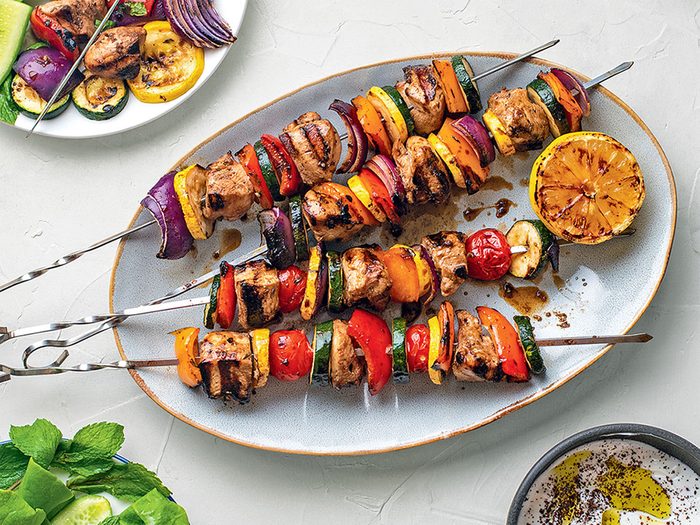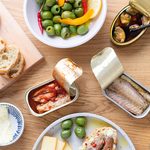How to Make the Best Grilled Kebabs

Master the art of grilling healthy kebabs every time.
Grilling season is underway, and while nothing beats a hot dog with the works, I also make room for a more nourishing and customizable dish. Enter kebabs. They’re easy to prep for a crowd, and have that flame-grilled flavour with a healthier spin. Here’s how to make them just right.
(Related: The Lazy Gal’s Guide to Grilling)
Healthy grilling tips
While there’s no direct correlation between grilled food and cancer, cooking over an open flame can create carcinogenic chemicals. These chemicals, HCAs and PAHs, develop when the proteins in meat react to high heat or when rendered fat drips into the flame. The occasional cook-out is not harmful to your health, but there are a few things you can do to limit HCAs and PAHs while grilling.
Lean meats are already a healthy choice to reduce your intake of saturated fats, but they also produce fewer drippings during grilling. Shrimp, chicken breast and flank steak all make good options, as do vegetables, fruit or plant-based proteins like tofu, which don’t produce HCAs and PAHs. Plus, lean meats won’t cause as many flare-ups during cooking, which cuts down on direct flame exposure.
When grilling, aim for burnished, not burnt. Limit charring by cooking over indirect heat, flipping frequently and cutting meats into smaller pieces so they cook faster, reducing potential exposure. I also like to place kebabs on aluminium foil or a grill pan to avoid contact with the flame altogether. You’ll still get that delicious grill-smoke taste.
(Related: 9 Pro Tips for Healthier Grilling)
Follow these marinade rules
Marinades add flavour and moisture, and provide a protective coating to meats, which minimizes harmful chemicals during cooking. You don’t actually need a lot of time: Just one hour of marinating can be enough to impart flavour, though meats can be safely marinated for more than 24 hours. However, acids like vinegar or lemon juice will eventually break down the proteins in meats, so limit those seasonings to about five hours to maintain your meat’s texture. For a more nutritious marinade, cut down on sugar, which can encourage charring and burning and makes for a messy grill.
Build it right
For a balanced kebab, cycle through a protein, a veg and an aromatic. The protein could be chicken, shrimp or beef, or tofu or halloumi for a vegetarian spin. For veggies, choose ones that cook in the same amount of time as the meat and won’t slide off the kebab. Bell peppers, zucchini, mushrooms and eggplant are all good candidates. Small potatoes and sliced cobs of corn are tasty options, too—just parboil them ahead of time so they cook at the same speed as the rest of the kebab.
To round out the kebab and add colour and flavour, weave in aromatics like onion and fruits like pineapple, mango, watermelon and peaches. I also love to grill up lemon and orange wedges, which become deliciously caramelized (though beware of charring). I then squeeze the juices over the kebabed meat and veggies after grilling.
Just like when you’re building a balanced plate, eyeball a ratio of one-half non-starchy vegetables, a quarter protein and a quarter aromatics or carbs for each kebab. Some of my favourite mixes are:
- pork, red bell pepper and pineapple
- shrimp, corn and potato sprinkled with Old Bay seasoning
- halloumi, zucchini and cherry tomato stack perfect for serving with pitas, tzatziki and hummus
Let this be your invitation to think beyond burgers and bratwursts and choose your own kebab adventure. The combinations are endless and work just as well for a big cook-out as for a weeknight dinner.
Next: How to Make the Ultimate Marinade for Summery Grilled Kebabs




